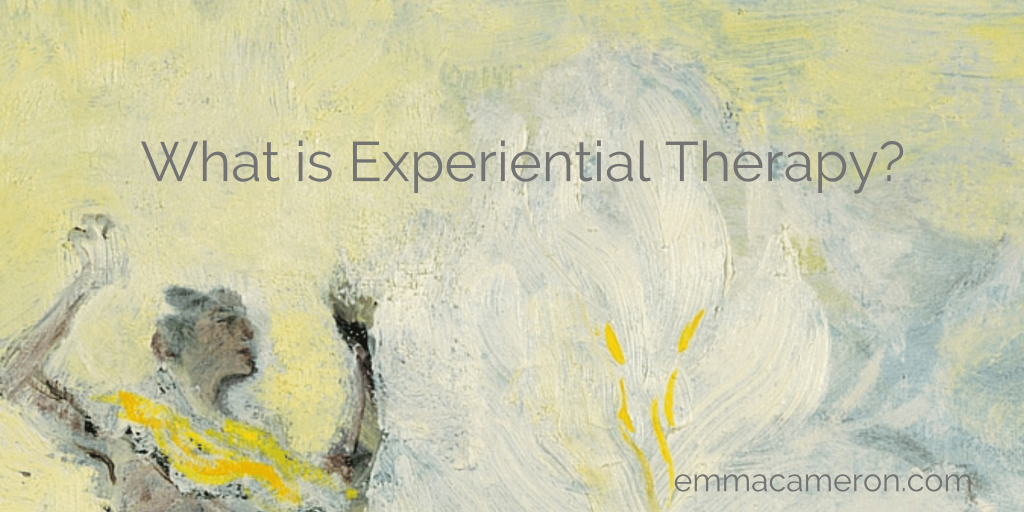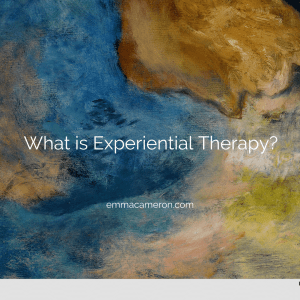
If you’ve ever looked for a psychotherapist or counsellor, you may have seen ‘I work experientially’ on some therapists’ websites and directory listings. But what is experiential therapy? And how might it impact you, as a client?
Experiential therapy is interested in you, however you’re feeling, right now
Many of us are used to the idea that in therapy, we can expect to talk about our experiences, thoughts, and feelings, past and recent. This happens in experiential therapy too. But in experiential therapy, you and your therapist will be particularly interested in what you’re experiencing, right now in this moment. This can include physical sensations and emotions, amongst other things. This can give useful information and helps guide the therapist in order to (we hope) be more effective in helping you.
Why have an experiential focus?
The simple reason that many therapists aim to keep an experiential focus within sessions is that it helps! It helps you get to the heart of the thing(s) you are coming to therapy for help with, and get real change to happen.
And most importantly, it helps you to process the mixed emotions that are typically at the heart of the issue. Processing the emotions allows you to then move on with your life, without being so burdened. It also helps you get more familiar and comfortable with your emotions going forward, so they stop being so overwhelming and scary (or flat and numb, as in the case of depression). Then you can live more freely, using and trusting in your emotions as helpful guides rather than sources of trouble.
What is Experiential Therapy? A simple explanation of why experiential types of therapy can be so helpful, and what happens in experiential therapy. #AEDP #ArtTherapy #Gestalt Share on XIn experiential therapy, all your feelings are welcome
It’s important to know that no feeling is ‘wrong’. You could be feeling neutral, bored, excited, anxious, angry, peaceful, sad, confused, happy; any number of things! Same with your physical sensations, like chest-tightness or stomach-churning, or hot in the face, or whatever. The main thing is to really try and be honest if you can, even if you fear it’s something that the therapist might not want to hear.
What does the experiential therapist do with what you tell them?
So what does an experiential therapist do with this info about your present-moment feelings?
Firstly, and most importantly, it helps them feel closer to you, and closer to understanding you better so they can help you more. Secondly, it can guide the therapy session, so together you can move in a helpful direction.
I’ll give a few examples of the sorts of things you might tell your therapist you’re experiencing in the moment.
You might tell your therapist:
1. I feel anxious
Funnily enough, if you feel anxious in your experiential therapy session, this isn’t such a bad thing! It can mean that you’re switched on and ready to engage with the difficult stuff that’s brought you to therapy. If your leg is jiggling, if your palms are a bit sweaty, if your chest feels a bit tight and you’re twisting a tissue in your fingers, or twiddling your hair – these signs of anxiety just tell us that you’re not too far away from potentially exploring some tricky mixed feelings. Because in many cases, mixed feelings underlie anxiety. For example, the fact that you may be feeling grateful and loving towards your parent, but furious with him/her as well. Your experiential therapist will be wanting to help you figure out what the mixed feelings may be, so you can actually process them.
Your therapist will also be on the lookout for any signs that your anxiety may be starting to rise too high in the session. Signs of overly-high anxiety include dizziness, panicky feelings, blurring vision and spacing-out. If these start happening, your therapist will help you to regulate the anxiety and get back to a more manageable level.
2. I feel numb, dizzy or nauseous
If you tell your therapist that actually right now you’re feeling a bit a bit numb, or dizzy, or nauseous, that lets them know that maybe there’s something very difficult (for you) in the topic or the situation. Your nervous system might have gone into hypo-arousal. This isn’t your fault, and it’s not that you’re getting something wrong. It’s just what bodies do sometimes, and it could be a signal that you aren’t feeling emotionally safe.
The experiential therapist can then help you feel safer and more present in the moment – whether that looks like changing the subject (e.g. talking about your cat), centring and grounding (e.g. mindful breathing; the 5-4-3-2-1 technique), a movement technique like patting your knees in a rhythm, or helping you figure out what would actually help you feel more comfortable in the room right now.
3. I feel neutral, bored, ‘fine’ or ‘okay’
If you really haven’t got much to say about what you’re feeling, because really there doesn’t seem to be much there right now, this might be a sign that you’re in more of a ‘chat’ situation as opposed to therapy. (And if a chat was what you wanted, you could probably go to a friend and it would cost a lot less!) Experiential therapists believe that therapy is only going to be really beneficial when you get into the realm of genuine, meaningful emotion combined with insight.
Again, though, you don’t need to worry about ‘doing it wrong’. Feeling neutral in your therapy session is simply information that can help you and your therapist know there’s more juicy stuff somewhere. Good experiential therapists aren’t just going to carelessly dig and poke until they hit on something upsetting, though. Instead, they know that we need to proceed gently, and respectfully. There will be good reasons why you aren’t engaging with your feelings right now, and we really need to honour that. (Especially if you have experienced trauma and/or are in a marginalised identity).
4. I have an image in mind
When your therapist asks what you’re noticing inside, you might find that instead of an emotion or a physical sensation, you find an image or metaphor popping into your awareness instead. This is great! It shows that your brain’s right hemisphere is on task. An image or a metaphor can say a huge amount – much more than a sentence or even a paragraph can. This is used commonly, of course, in Art Therapy (which is a prime example of experiential therapy), but many other therapists too value and welcome metaphors as a wonderful window into the person’s experience.
5. I feel an emotion
Your response to ‘what are you noticing inside right now’ might be a simple emotion: ‘I feel sad’ or ‘I am feeling proud of myself’ or ‘I feel angry’. It might be a mixture of emotions: ‘I feel sad and also kind of grateful’ or ‘I feel furious with my Mum, but I really love her too’. Or you might at first be aware of a ‘felt sense’ – a mixture of physical sensation coloured by something emotional: ‘There’s a sense deep inside me of something quite strong’ or ‘My heart feels really open and tender’.
6. I feel a physical sensation
The most obvious things you’re aware of inside could be quite simple physical sensations. You can tell your therapist about anything you’re noticing: aches and pains, areas of tightness and tension, relaxation and warmth, or just ‘I’m feeling chilly – could we put the heating on?’
7. I have a feeling towards the therapist
When your experiential therapist asks what you’re noticing inside, you might become aware of having a feeling (or a mixture of feelings) towards the therapist. You might, for example, be feeling really quite irritated by this person who keeps asking you how you’re feeling! Alternatively, you might feel touched by their interest and care for you. You might feel recognised, really seen by your therapist in that moment, and this might bring up its own set of new feelings as you tune into realising what you never (or rarely) had in the past. Sometimes you might be aware of having a loving or longing feeling towards them.
If your experiential therapist works relationally, and is trained in a relational model (like AEDP, ISTDP, Gestalt, integrative psychotherapy, or relational depth psychotherapy), they should be well equipped to use relational experiences in a way that really helps progress the therapy in a positive way. (However, it’s worth knowing that some counsellors, most CBT practitioners, and some EMDR practitioners aren’t thoroughly trained in relational paradigm, unfortunately).
What kinds of therapy are experiential?
Therapy modalities that are experiential include: AEDP (accelerated experiential dynamic psychotherapy), ISTDP (intensive short-term dynamic psychotherapy), Gestalt therapy, equine-assisted therapy, Integrative Arts Psychotherapy, body psychotherapy, SE (somatic experiencing), Sensorimotor therapy and EMDR. Some integrative psychotherapists and integrative counsellors also work experientially.
More details about experiential therapy
If you’d like to find out more about experiential therapy, see what I’ve written in Part 2, ‘What Do Experiential Therapists Ask?’ There I give some ideas of the kinds of things an experiential therapist might say, and how they might keep an experiential focus in sessions. I also offer a list of some types of therapy which are experiential.
Has this been helpful?
I hope this brief introduction to experiential therapy has been helpful. I’d love if you could comment below and let us know what experiential therapy means to you!
